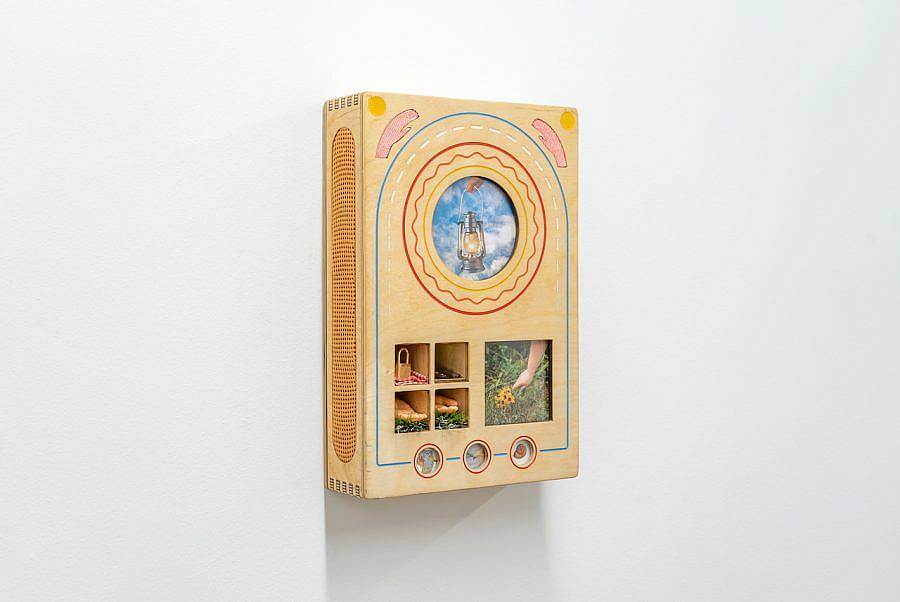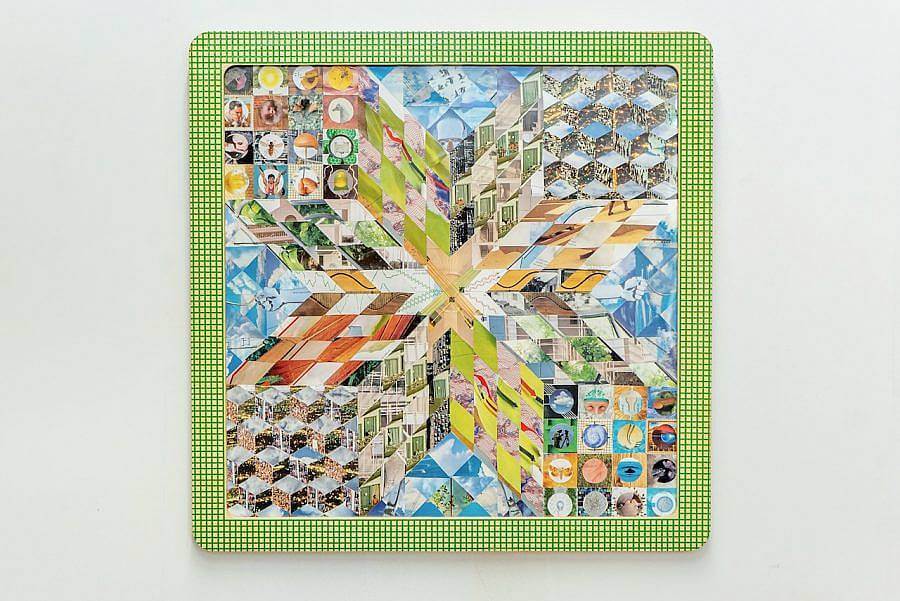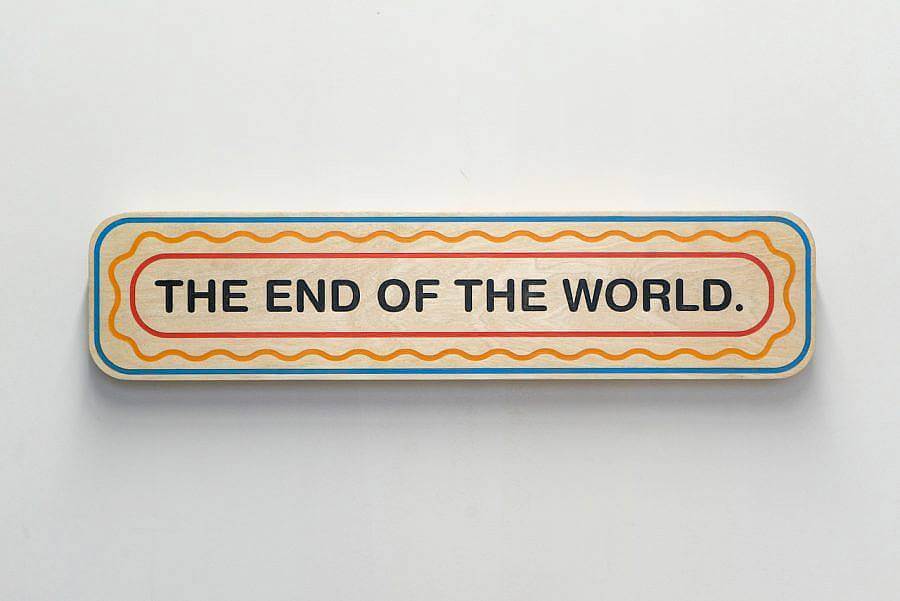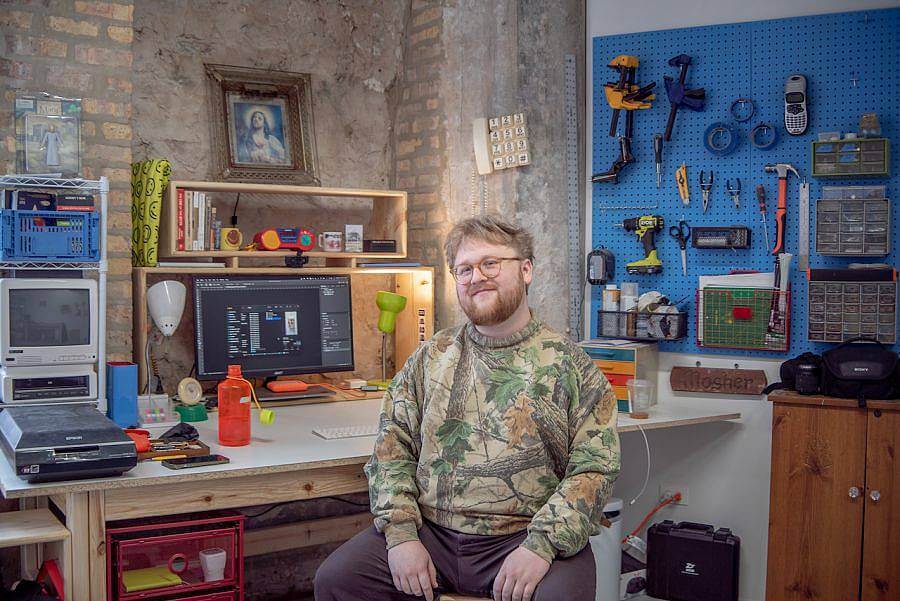Tell us a little bit about yourself and what you do
So when I started really pursuing art a few years ago, my practice was originally almost completely based in hand-cut collage, but over the past few years, particularly during my time getting an MFA at SAIC, I really tried to branch out into as many different mediums as I could whether it be photography, sculpture, installation, projection mapping, lenticular printing, etc. And over time I’ve kind of embraced being an amateur at a bunch of different things and just trusting my own taste. But conceptually my work is about the endless contradictions of being a human being in America right now, specifically in the context of spirituality, capitalism, and the general feeling that everything is falling apart around us but that we’re expected to find ways of coping with that.

Tell us a bit about your solo show Biofeedback.
So this concept of ‘biofeedback’ is something I’ve been thinking about for a really long time, and originally it was something I thought about in the context of making music. This sense that feeling an instrument vibrate while you’re playing it is an essential part of the creative process that, at least for me, was lost when trying to make music on a computer with headphones on in my dorm room in undergrad. I experienced something super similar when I started experimenting with adapting my hand-cut collage practice into video-based works and having the vast majority of my creative process happen on the computer. Basically what I experienced was this intense feeling of alienation from my own practice. And I’ve been trying to alleviate but also explore that feeling with a lot of the pieces that are in this show. So it’s really all about exploring the concept of tactility by having a physical relationship with my work whether its laboring over super detailed hand-cut collages, or sanding, assembling, and painting the wood sculptural pieces and frames, or collecting and arranging found objects.
But I think also referencing a certain kind of ‘craftsmanship’ while using lasercutting is also a kind of tongue and cheek nod to what I see as a super pervasive loss of tactility in American culture. I think about this a lot particularly with technological interfaces like touch screens and the general trend towards making technology less and less tactile. I tend to think that this moves us towards having less and less of a healthy barrier between us and the technology we’re increasingly unable to avoid using all the time. And so in a way, both in the process of making these pieces for myself and also for the viewers, I’m trying to create less-technological interfaces for people to have healthy relationships with. And this really ties back to my interest in religious objects: this idea of having objects that don’t necessarily serve a purely practical purpose but are there to momentarily hold our attention.

How do you typically select the colors in your works?
Well with this batch of work is really my first time being super intentional about color to be honest. But I really also wanted to evoke this feeling and aesthetic of toys, and colors I associate with my childhood. Specifically, things like the “My First Sony” radios that have all of these great designs and primary-color schemes. I think this sort of deep feeling of having a tactile relationship with my practice is also super rooted in play, and so it kind of came naturally to think of these pieces as toys that I was assembling like a Lego set, which is something I’ve thought about a lot with my collage practice, that my practice tends to tap into an inner-child type of thing. But I’m also thinking and reflecting on a lot of sort of grim and serious topics in the work, so it’s almost like having a dialogue with my inner child through the process of making the work, and I was kind of surprised to find that people were intrinsically resonating with it on that level which was one of the things that made me want to pursue this visual language more. It felt like I had tapped into something that I couldn’t really articulate in any way other than continuing to make work, which is always a fun exploratory process. I think a piece like a sign of the times is a good example because it’s a super distilled and up-front representation of the themes of the project. Like “how do you explain to your inner child that the world is ending?”. And I think a lot of that has to do with the way color and lines are treated in the engravings. I think they kind of feel old and new at the same time which is a contrast I’m super into.

Can you talk a bit about your upbringing in Massachusetts and your decision to pursue graduate studies in art after studying religion in your undergrad?
My upbringing was super idyllic for the most part. I grew up in an incredibly beautiful place by the ocean and especially after leaving, my upbringing feels like a dream from a past life or something. And I think growing up there and having a super close relationship with the natural environment, the woods, the beaches, the weird little marshes, riding my bike everywhere, and having these super euphoric summers after long lonely winters was really where my interest in religion and spirituality started. I was raised by two excommunicated Catholics, one of which was an atheist and the other still took me to church and had me confirmed and all of that. But going through that whole process and then learning that my dad didn’t believe in God made me experience a lot of resentment towards the whole idea of religion. But later in my teens I developed what I felt like was a kind of spiritual relationship with the beautiful environment I was living in that felt completely unrelated to religion. And so when the time came to go to college it felt like exploring those contradictions was the only thing I was interested enough in to commit myself to in an academic setting. This eventually culminated in an undergrad thesis project on the creation of “prayer towns” in colonial Massachusetts, which were created by English colonists to convert Indigenous people (primarily the Wampanoag, Nipmuc and Masschusett nations) to Puritan Christianity. And the process of learning about this history that took place where I grew up was also a process of rooting a lot of the ideas I had about religion, spirituality and indoctrination in historical events rather than my own personal experience.
Throughout this whole period of time, I was also making art, but was not really ready to get constructive feedback on that work, and preferred to treat it more casually. But a couple of years after graduating from undergrad I met my fianceé Elizabeth who was getting her master’s in Art History at the time. And really, opening myself up to her insights about the strengths and weaknesses of my practice at the time, and also beginning to contextualize my artistic interests in art history and contemporary art was really what gave me the motivation to pursue my collage practice more seriously. She gave me a bunch of her study materials which included images of early Rennaissance religious paintings like Giotto’s Madonna Enthroned, and introduced me to the work of people like Hannah Höch and other Dadaists. From there I started making collages based on the compositions of those religious paintings. These experiments eventually snowballed over the course of a year or so into the portfolio that I used to apply to SAIC, which was a series of 18 x 24” and larger collages that satirized American culture in the Trump era by creating quasi-religious scenes from magazine clippings.

What role do you think social media should play within an artist’s studio practice?
Well honestly I kind of feel like social media is a necessary evil that artists are forced to participate in. It’s obviously a useful tool for us to promote ourselves, connect with other artists, and getting the validation that people are paying attention to your work can be a good motivator to keep going, but it also feels like a performance in a lot of ways. That being said, I think my relationship with my social media, has become a lot more measured over the past couple of years, and I feel like I see it mainly as a way of showing people finished pieces, rather than feeling the need to bring people inside the process. But I do love seeing what other artists are working on, and seeing how people set up their work spaces and what their process looks like, but I think it’s all a matter of how the artist feels about maintaining that kind of relationship with their audience. It can feel like a chore sometimes. I will say though that I have been able to connect with so many amazing artists here through social media that I may not have crossed paths with in the real world as easily, so that is a huge positive that makes it worth while.
Many of your works are sculptural and interact with the wall in a fashion that is reminiscent of paintings. Can you talk about the decisions to mount the works and the ways you hope the viewers will interact with them?
I think a lot about things that are generally considered to be peripheral to artworks but not necessarily part of them, like frames, titles, gallery walls, and how I can make work that makes those things feel like cohesive parts of the work rather than just adjacent to the work. This started with experimenting with designing frames for collages, but then I thought, “what if I start with the frame and work backwards from there?” (The piece mnemonic hands is an example of this.) This turned the frame/image dynamic on its head in a way that was super fun and I feel like I’m still exploring that in a way. This is a big underlying theme with a lot of the work in Biofeedback. The work in the show is really kind of a spectrum of the frame taking over the image and becoming its own sculptural thing. But I think especially with the box piece like the body is a gilded cage and reliquary, I wanted them to feel like they were extensions of the wall. I look at a lot of public architecture as inspiration for the work too. Things like call-boxes, street signs, water fountains, that seem to be inseparable from their physical environment despite being independently designed objects.

There are recurring symbols in your work (ex.hands), what do these and your other subject matter represent to you?
Symbols are one of the many things I’ve gotten fixated on over the past few years. I have a couple of books of symbols that I’ve picked through in a similar way to my collage practice and I’ve scanned them and collected them in an Illustrator document where I pull from them and essentially collage with them or just use them as inspiration. These collected symbols show up directly in the painted laser engravings on a lot of the pieces. This obsession was partially inspired by Xu Bing’s Book from the Ground, which tells a story using a bunch of symbols and emojis and no words. I saw this super clear connection between that method and my collage practice and eventually was able to get a big enough backlog of collected symbols to start working in a similar way to how I do with collage. But as far as meaning, particularly with hands, it really ties back to this idea of tactility and creating a sort of religious visual language around tactility.
Do you have any daily rituals?
I wouldn’t say I have daily rituals, but I think the closest thing I have to a ritual is really the process of collecting and arranging images, objects, symbols etc. This process is really at the root of my practice in a lot of ways. I’ve been trying over the past year to become more intentional and measured about it but it’s one of those things I really need to set aside time for. But there is this really specific process of patiently sitting with images or objects and seeing how they interact with each other to form new meanings and associations that feels super ritualistic and magical to me.

What shows have you seen recently that are exciting to you?
Alex Chitty’s recent solo show at Patron Gallery was a game changer for me. She was one of my advisors during my last full semester at SAIC and I had the opportunity to visit her studio and see her process. Being able to see the finished work after that really had a big impact on how I looked at my own practice. As an advisor, Alex really has a way of giving you strategies of deconstructing your pratice and breaking the rules you’ve set for yourself and that is something that I continue to try to remind myself to do. And it’s always interesting seeing how somebody’s advice manifests itself in their own practice so it was really like watching the process of an artistic outlook manifesting in the work rather than seeing the work first and then figuring out what’s going on behind it, which is such a rare instance to be exposed to with an artist you admire. But this show in particular encapsulated this quality that’s become super important to my own practice which is basically starting from some kind of playful, generative, or hands-on process like drawing and then building on top of that. Seeing that a lot of Alex’s wall sculptures, which are these incredible compositions and are comprised of these really carefully chosen and refined materials, that they started from these big crazy drawings that didn’t even particularly look like “plans for wall sculptures” at all, was a crazy revelation about how a creative process doesn’t have to be just free creative intuitive expression or this sort of calculated process that’s hyper focussed on aesthetics and is very intentional. Because it was clear that she had found a way to marry those two things in such an interesting way. And the result is these pieces that have an incredibly “professional” and refined appearance materially but are based on this foundation of playfulness, and are still imbued with a playful essence because of that foundation.
So this contrast or combination between playfulness but also having a kind of material rigor and care and refined-ness in the end product is something that has become super important to me. Another show that I feel like really tapped into this for me was a group at the March SAIC MFA Show, aptly called Serious Play. This was made up of work by Yutian Liu, Christian Gutierrez and Izzy Cho. The three of them were my cohort-mates in the Printmedia department at SAIC and of course in SAIC tradition there was maybe one traditional “print” in their show. But all of their work which ranged from sculpture to collage to flag-making really embodied this combination of taking a playful foundation and executing it in a very thought-out and considered manner that still preserves that playfulness.
Izzy actually also did a huge chunk of the laser-cutting and laser-engraving work for the pieces that are in Biofeedback. This was a new experience for me, outsourcing any part of my process, and it was coincidentally a conversation that I had with Alex Chitty that made me start to rethink my resistance to outsourcing. Realizing how much creative control she was able to maintain across all aspects of the production of her work despite having metal fabricators, woodworkers, and powder-coaters helping to produce parts of each piece, opened up a big door for me. I think I had this notion that a lot of young artists entering the contemporary art field have where there’s a lot of pride around doing everything yourself, or that there’s something creatively impure about allowing others to help you execute your ideas. And I think it was really this exploration of where the real creative process happens, that its often in the planning rather than the execution, that began to make me more comfortable with that.

Any upcoming projects you are looking forward to?
Honestly right now I’m trying to take some time to reset and take some space from my work while this show is up. It’s been a super busy year, which is great, but I’m looking forward to slowing down and exploring new territory. I’m visiting home in July which always tends to kind of reset my brain, so I think when I get back from that trip, I’ll start figuring out where to go next and reorienting myself for my solo show at The Martin that’s coming up this fall.
One of the things I’ve been looking forward to for a while is a collaboration with my close friend Maddie May. Maddie is one of the few people who I really felt like I clicked with on an art level at SAIC and she played such a huge role in pushing me and my practice throughout that process. We’ve been talking about collaborating on something for a while now and I think this summer we might actually both be in the right headspace to get into it. Not really sure what that will look like yet but we both have a practice that’s super rooted in collage and found objects, and more recently sculpture.
Interview Conducted & Edited by Ben Herbert.
